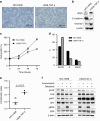Epithelial-mesenchymal transition status is a remarkable biomarker for the combination treatment with avutometinib and defactinib in KRAS-mutated non-small cell lung cancer
- PMID: 38822146
- PMCID: PMC11263561
- DOI: 10.1038/s41416-024-02727-2
Epithelial-mesenchymal transition status is a remarkable biomarker for the combination treatment with avutometinib and defactinib in KRAS-mutated non-small cell lung cancer
Abstract
Background: Recent therapeutic strategies for KRAS-mutated cancers that inhibit the MAPK pathway have attracted considerable attention. The RAF/MEK clamp avutometinib (VS-6766/CH5126766/RO5126766/CKI27) is promising for patients with KRAS-mutated cancers. Although avutometinib monotherapy has shown clinical activity in patients with KRAS-mutated cancers, effective combination strategies will be important to develop.
Methods: Using a phosphorylation kinase array kit, we explored the feedback mechanism of avutometinib in KRAS-mutated NSCLC cells, and investigated the efficacy of combining avutometinib with inhibitors of the feedback signal using in vitro and in vivo experiments. Moreover, we searched for a biomarker for the efficacy of combination therapy through an in vitro study and analysis using the The Cancer Genome Atlas Programme dataset.
Results: Focal adhesion kinase (FAK) phosphorylation/activation was increased after avutometinib treatment and synergy between avutometinib and FAK inhibitor, defactinib, was observed in KRAS-mutated NSCLC cells with an epithelial rather than mesenchymal phenotype. Combination therapy with avutometinib and defactinib induced apoptosis with upregulation of Bim in cancer cells with an epithelial phenotype in an in vitro and in vivo study.
Conclusions: These results demonstrate that the epithelial-mesenchymal transition status may be a promising biomarker for the efficacy of combination therapy with avutometinib and defactinib in KRAS-mutated NSCLC.
© 2024. The Author(s), under exclusive licence to Springer Nature Limited.
Conflict of interest statement
TY received research grants from Ono Pharmaceutical, Janssen, AstraZeneca, and Takeda Pharmaceutical and a personal fee from Eli Lilly. KT received research grants from Chugai Pharmaceutical and Ono Pharmaceutical and personal fees from AstraZeneca, Chugai Pharmaceutical, MSD-Merck, Eli Lilly, Boehringer-Ingelheim, and Daiichi-Sankyo. TS received research grants from Otsuka Pharmaceutical, Taiho Pharmaceutical, and Oncolys BioPharma and a patent fee from JT Pharmaceutical. The remaining authors declare no potential conflicts of interest.
Figures





Similar articles
-
Preclinical evaluation of avutometinib and defactinib in high-grade endometrioid endometrial cancer.Cancer Med. 2024 Sep;13(17):e70210. doi: 10.1002/cam4.70210. Cancer Med. 2024. PMID: 39240189 Free PMC article.
-
Preclinical in vitro and in vivo activity of the RAF/MEK clamp avutometinib in combination with FAK inhibition in uterine carcinosarcomas.Gynecol Oncol. 2024 Aug;187:12-20. doi: 10.1016/j.ygyno.2024.04.010. Epub 2024 May 3. Gynecol Oncol. 2024. PMID: 38703673
-
Preclinical efficacy of RAF/MEK clamp avutometinib in combination with FAK inhibition in low grade serous ovarian cancer.Gynecol Oncol. 2024 Apr;183:133-140. doi: 10.1016/j.ygyno.2024.01.028. Epub 2024 Mar 15. Gynecol Oncol. 2024. PMID: 38493021
-
Prognostic value of KRAS mutation in advanced non-small-cell lung cancer treated with immune checkpoint inhibitors: A meta-analysis and review.Oncotarget. 2017 Jul 18;8(29):48248-48252. doi: 10.18632/oncotarget.17594. Oncotarget. 2017. PMID: 28525386 Free PMC article. Review.
-
KRAS oncogene in lung cancer: focus on molecularly driven clinical trials.Eur Respir Rev. 2016 Mar;25(139):71-6. doi: 10.1183/16000617.0071-2015. Eur Respir Rev. 2016. PMID: 26929424 Free PMC article. Review.
Cited by
-
Combined inhibition of focal adhesion kinase and RAF/MEK elicits synergistic inhibition of melanoma growth and reduces metastases.Cell Rep Med. 2025 Feb 18;6(2):101943. doi: 10.1016/j.xcrm.2025.101943. Epub 2025 Feb 7. Cell Rep Med. 2025. PMID: 39922199 Free PMC article.
-
Anti-tumor efficacy of RAF/MEK inhibitor VS6766 in KRAS-mutated colorectal cancer cells.Cancer Chemother Pharmacol. 2025 Jul 31;95(1):78. doi: 10.1007/s00280-025-04799-0. Cancer Chemother Pharmacol. 2025. PMID: 40742567 Free PMC article.
-
Nuclear Focal Adhesion Kinase Protects against Cisplatin Stress in Ovarian Carcinoma.Cancer Res Commun. 2024 Dec 1;4(12):3165-3179. doi: 10.1158/2767-9764.CRC-24-0382. Cancer Res Commun. 2024. PMID: 39585085 Free PMC article.
-
The mechanopathology of the tumor microenvironment: detection techniques, molecular mechanisms and therapeutic opportunities.Front Cell Dev Biol. 2025 Mar 18;13:1564626. doi: 10.3389/fcell.2025.1564626. eCollection 2025. Front Cell Dev Biol. 2025. PMID: 40171226 Free PMC article. Review.
-
Preclinical evaluation of avutometinib and defactinib in high-grade endometrioid endometrial cancer.Cancer Med. 2024 Sep;13(17):e70210. doi: 10.1002/cam4.70210. Cancer Med. 2024. PMID: 39240189 Free PMC article.
References
MeSH terms
Substances
LinkOut - more resources
Full Text Sources
Other Literature Sources
Medical
Research Materials
Miscellaneous

